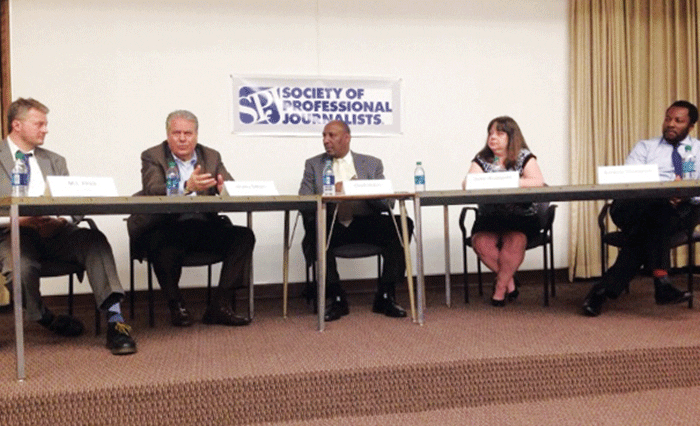
|
| Panelists included (L-R) FOX News investigative reporter, M.L. Elrick; Osama Siblani, publisher of The Arab American News; Chuck Stokes, editorial/public affairs director for WXYZ TV 7; Jackie Headapohi, managing editor, Detroit Jewish Newsand Bankole Thompson, editor of the Michigan Chronicle |
DETROIT — The face of America is changing. It’s projected that by 2050, minorities will represent half of the U.S. population.
In order to adapt to the cultural shift in demographics, news outlets are trying to increase the number of minorities working in the profession. There is an essential need for the new generation of journalists to reflect the diverse population.
Cognizant of that fact, the Wayne State University Society of Professional Journalists held a panel discussion on Thursday, April 16 about the importance of diversity in the media.
Panelists included Osama Siblani, publisher of The Arab American News; Chuck Stokes, editorial/public affairs director for WXYZ TV 7; Bankole Thompson, editor of the Michigan Chronicle; Jackie Headapohi, managing editor, Detroit Jewish News and Pulitzer Prize winning journalist and FOX News investigative reporter, M.L. Elrick.
“There are way to many people in the media who look exactly like me and almost everyone in charge in the media looks exactly like me, with a couple of women thrown in,” Elrick said.
He discussed some of the issues he encountered as an investigative reporter.
“One of the problems I encounter is when people criticize my stories, they start off with, ‘well you’re a White guy and no one ever gets the real issues of what’s behind the stories,’” Elrick said. “Because that becomes the real dodge that everyone can use.
“When you see somebody you can immediately identify with talking about issues you know and care about, I think it is easier to get to the issues,” he added.
Elrick said there needs to be more people of color doing investigative reporting, especially in a diverse city like Detroit.
“What bothers me is when people see the work that is done, I think they feel a little detached from it,” he said. “They say, ‘you know what this person doesn’t speak for me, partly because they don’t look like me.’ Now, I really think we need to get rid of that.”
Thompson said he doesn’t think there is an African American who covers Lansing, which he finds troubling because the delegation that represents Detroit in Lansing is majority African American.
Siblani recalled an incident where the Arab community had an issue with the Detroit News and members called for a meeting with then-publisher and editor Mark Silverman. Siblani said Silverman agreed and disagreed with some of the community’s concerns.
According to Siblani, after the meeting Silverman looked at him and said, “I do not want to lie to you, the Detroit News has been in business for more than 100 years. You can’t change the Detroit News that quickly. It is not that flexible to change it like this.”
“At that moment when I left, I thought a newspaper that thinks like this will not survive in a world that is changing so fast,” Siblani said. “So if you do not change fast you are done, finished.”
Siblani said diversity is not only putting people around the table who look different, but learning from each other, understanding each other, tolerating each other and accepting each other, even when we have different points of view.
Siblani acknowledged Wayne State University professor Dr. Hayg Oshagan during the event and discussed his role in establishing New Michigan Media. The board members of New Michigan Media consist of the publishers of the five largest ethnic media outlets in Michigan.
“He understood diversity and brought it into action,” Siblani said.
Headapohi said there has been progress in diversifying newsrooms over the years, but there is still room for improvement. She said women in the media still earn less than men.
“I would like my daughter and granddaughter to live in a world that has equal pay for equal work, ” she said. “Some progress to be made there.
Stokes said there is more diversity in WXYZ’s staff today than in the entire time he has been there. In recent years, a lot of people retired from WXYZ and it gave the news outlet an opportunity to hire more people of very diverse backgrounds.
Stokes and Elrick said while there has been progress over the years in incorporating more diversity into newsrooms, there has not been enough in all areas.
Elrick had advice for the students:
“What I tell all my students is, this is a business of rejection,” he said. “Nobody wants to hire you. When they do hire you, nobody wants to let you do the stories you want to do; and when you get to do the stories you want to do, nobody wants to talk to you. Now, if you give up on the first ‘we don’t want you; we don’t need you and you don’t belong in this business’, the second one you have to fight through and the third one you have to fight through.”
Journalists who can identify with the communities they cover tend to be more sensitive to them in their reporting.
“I think entities like the media, they have to connect to those demographics,” Thompson said. “If not, they will not survive. There are so many cultural shifts that I think the media has to adapt to.
“If, in fact, the mainstream press is to remain relevant in this growing mainstream shift that we are seeing in this demographic, it has to change,” he added. “You better make sure there is a cultural connection between the people you send out to cover certain communities.”






Leave a Reply